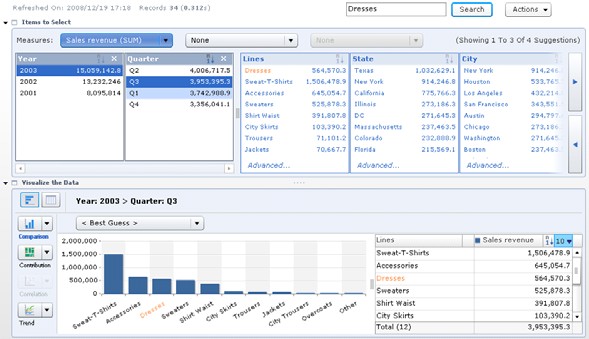Jon Schwarz, SAP Executive Board Member, gave the global press conference at SAPPHIRE this morning, with a focus on BusinessObjects Explorer (formerly known as Polestar) and how it helps their customers to become clear enterprises: seeing, thinking and acting clearly. As Prashanth Rai twittered, it’s more like a mini keynote than a press conference, or at least this part of it.
SAP is seeing a fundamental change in customer expectations, both from the buyers and the users. Buyers need to do more with less, which means reducing total cost of ownership, making it easy to deploy solutions, and getting to ROI faster. Users now want the same level of usability and sophistication of digital media as they see in consumer applications (surprise!), as well as wanting to integrate social and community aspects.
Their strategy:
- Building on their core business process platform
- Best foundation for an intelligence platform since the acquisition of Business Objects
- Next-level BPM, presumably through NetWeaver BPM (although he didn’t state that explicitly)
- On premise and on demand solutions
- Web 2.0-like user experience
- Non-disruptive evolution through timeless software
Marge Breya, EVP and GM of Business Objects and NetWeaver, took the stage to talk about how data is used within organizations, and pointed out a 2007 BusinessWeek research study that showed that most people don’t think that they have the right data (and granularity of data) to do their job, and poor decisions are being made due to lack of information. She then introduced BusinessObjects Explorer, a front-end tool for exploring and visualizing large data sets, both for casual and power users. It allows for searching and sorting, interactive drilldowns, and various types of dynamic graphical visualizations while navigating through the data. This can be done in the context of a SAP report screen, and she showed an experimental version running on an iPhone. In the next year, they’ll be opening up the data sources so that this can be used as an interactive analysis and visualization tool against data warehouses, flat files and other data sources. Currently, there’s a regular version, which good for up to about 1M records, and an accelerated version for much larger data sets. There are, of course, other data analysis and visualization tools in the BusinessObjects portfolio: Xcelsius, Crystal and WebI; the challenge will be a clear delineation of the usage of each of these products, or a consolidation of some of these to create a more compact portfolio.
She was then joined on stage by a panel of customers and partners: Vincent Vloemans from Sara Lee, Katrina Coyle from Molson Coors, Elke Reichart from HP and Alexander Yost from IBM. The two customers have been using Explorer and had lots of good things to say about the speed of analysis (2-3 seconds on data sets of 300M records), the fast learning curve for users with little or no training, and the short time to value. The partners discussed how their hardware optimizes the performance of this solution – apparently, a nice IBM or HP blade server will help things out considerably – and how they are shipping preconfigured and optimized systems.
Schwarz came back up to walk through a more traditional set of press announcements, including their acquisition of Clear Standards; you can read all of the news releases in the news room. We then had an audience Q&A, which ranged across a variety of subjects including the potential for appliances for products such as BusinessObjects Explorer (nothing to discuss yet, but apparently in the works), the role of business and IT in the creation and maintenance of data visualizations and other user-facing information (don’t fire your IT staff yet), sustainability (they’re for it), and the necessity for good data hygiene (seriously).
If you’re on Twitter, #sapphire09 is one of the top trends today. With 10,000 attendees on site and another 8,000 registered online for virtual participation, that’s not surprising.

